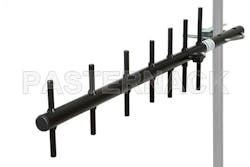Antenna Performance Criteria (Gain and Radiated Efficiency) – Part 1
RF Antennas
Antennas are used to channel radio waves for the purpose of communicating information across distances without wires. Antennas are necessary for a radio receiver or transmitter to convey signals between, for example, radio and television broadcast, cellular networks, Wi-Fi devices, radar and GPS, and remote control devices. Antennas transmit and receive radio waves which can be often be polarized by adjusting the axis of the antenna. As there are many different types of transmitting and receiving devices, there are equally a variety of antenna types to meet this transmission need.
Performance Indicators
An antenna’s performance is generally characterized by basic RF indicators, such as antenna gain and efficiency. An antenna should cover all intended frequency ranges with a reasonable impedance matching and high radiation performance. Many antenna properties are the same for both transmitting and receiving which simplifies testing and measurements for the following performance indicators. For example, it may be more useful to calculate the gain of a transmitting antenna than the area of a receiving antenna; likewise, it may be more useful to measure the receiving power pattern than to measure the transmitting power pattern of a large radio telescope. Thus, this receiving/transmitting reciprocity simplifies antenna calculations and measurements.
Gain
Gain, measured in Decibels (dBi), is the performance indicator that refers to directivity and electrical efficiency. In an antenna, gain measures the degree of directivity of the radiation pattern such that a high gain antenna would radiate power in a directional manner while a low gain antenna would radiate over a wider angle. High gain antennas propagate the signal further in one direction allowing for longer range without an increase in signal strength, but requires precise aiming toward a receiver. Conversely, low gain antennas have a shorter range but do not necessarily require being aimed at the receiver. Examples of these include a high gain satellite dish versus a low gain and Omni-directional cellular phone built-in antenna.
The isotropic antenna is a hypothetical model that radiates equal signal power in all directions and is used as the base of comparison to calculate the gain of real antennas. While no real antenna has an isotropic radiation pattern, several antenna types have a uniform radiation pattern on the horizontal plane. In this sense, antennas can be either directional or Omni-directional, depending on their application.
A directional antenna is used to maximize its coupling to the electromagnetic field in the direction of the other station. This type of antenna is preferred in small scale environments, as the system can be tuned for optimal use so that when focused, the smaller the percentage of 360 degrees that the signal radiates, the farther the reachable distance the signal travels.
Because an Omni-directional antenna receives and transmits at a 360 degrees radius, the signal radiates uniformly in all directions. Antennas that are, by design, quite small compared to the wavelength, cannot be highly directional. Gain, therefore, is not a measure the overall efficiency of an antenna and can only determine the efficiency of radiated output in one direction.
Radiated efficiency
The power required to achieve a certain performance level can be determined by radiated efficiency – a useful and informative measure of an antenna’s power efficiency and demonstrates the antenna’s capability to use the power fed to the terminals. The ratio of the power delivered to an antenna relative to the power radiated from the antenna is the radiated efficiency of the antenna.
With the ideal antenna, it would transform all of the power fed to its terminals to a radiating electromagnetic energy that propagates to the surrounding space. However, in real applications, some of the power fed to the antenna terminals is lost. Examples of loss include the mismatch between the antenna element and the feeding network and natural losses due to resistances of the conductors used to make the antenna.
In antenna design, radiated efficiency does not consider radiation direction and thus is a useful performance indicator for measuring the efficiency of, for example, cellular devices and other Omni-directional radiation patterned devices. Conversely, if the antenna is supposed to radiate in a specific direction such that the antenna is designed to have directive characteristics in its radiation pattern, then gain is a better performance indicator. Increasingly, there are more applications that require an Omni-directional signal and radiated efficiency, in these applications, is becoming the preferred test method. With radiated efficiency, the efficiency and performance are for all areas surrounding the antenna can be determined.
